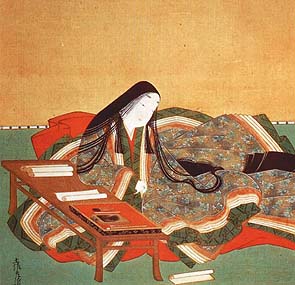
Murasaki Shikibu, illustration by Tosa Mitsuoki (1617 – 1691), who did a series on The Tale of Genji. Public Domain.
What was the first “real” novel? Who wrote it?
Many people cite Cervantes’ Don Quixote as the first modern European novel, and Defoe’s Robinson Crusoe as the first English novel, but were either of these really the first?
Though the modern concept of the novel has roots tracing back to Classical Greece and Rome, and has precursors in epic verse, the first novel, as we define it today, appeared in 11th century Japan. Written by Murasaki Shikibu, a lady-in-waiting at the Imperial Court, The Tale of Genji was definitively completed by 1021, but more likely finished around 1012.
Already an established writer, Murasaki came to court around 1006, serving as a lady-in-waiting to Empress Shōshi, during which she she continued writing. Though it does not have a plot as such, The Tale of Genji follows a central character through the events of his life, as well as a multitude of other well-developed major and minor characters throughout the story. Genji is the son of an emperor, but is removed from the line of succession by his father for political reasons. Now a commoner, we follow Genji’s rise and fall through his romantic exploits (there are a lot of them!), multiple emperors, and ultimately, to his death. After his death, the remaining nine chapters deal with Genji’s descendents.
Murasaki Shikibu was most likely brought to court to educate the Empress Shōshi. Though women themselves had limited power, they could have quite a lot of influence. It’s quite likely Shōshi’s father wanted his daughter to have as influential a salon as her rivals, which meant she needed to be educated. There were at least two other female writers in the salon, Izumi Shikibu and Akazome Emon.
Unfortunately, though we know a fair bit about Murasaki Shikibu’s life, we don’t know her real name. The standard practice during the Heian period was to not record given names. Instead, what wasrecorded were titles from fathers and/or husbands. However, “Murasaki” was bestowed on her in tribute to her skill as a writer; Murasaki was a beloved wife of Genji.
The best bit about The Tales of Genji, though? Not that it’s considered the first novel and is written by a woman. Not that it’s author was a highly educated woman for her time (she was fluent in Chinese when no Japanese women were taught Chinese). Rather, it features over 400 characters and was written over several years, and yet the consistency is astounding. The characters all age at the same rate and societal relationships are maintained throughout. Eat your heart out, George R. R. Martin!
-Katie Weidmann
Social Media Manager
Girl Museum Inc.
This post is part of our 52 Objects in the History of Girlhood exhibition. Each week during 2017, we explore a historical object and its relation to girls’ history. Stay tuned to discover the incredible history of girls, and be sure to visit the complete exhibition to discover the integral role girls have played since the dawn of time.
Want to read The Tale of Genji? Click here for a summary, or read a discussion of four English translations of the tale on The New Yorker.
